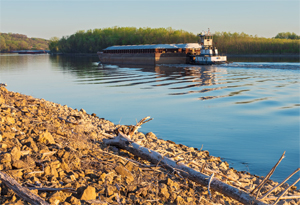A spring collision on the Mississippi River that resulted in several fatalities has spurred the U.S. Coast Guard to ramp up efforts to get two points across about automatic identification systems: that it’s unsafe to rely solely on the communication tool to know what vessels are nearby, and that improper entry of AIS data can even be deadly.
Toward that end, the Coast Guard is strongly urging vessel owners and operators to make use of a downloadable AIS Encoding Guide that spells out exactly how to properly update information and best use the technology, said Jorge Arroyo, a Coast Guard AIS specialist.
Mariners have an obligation to accurately enter static information such as the length, name and other characteristics of their vessels into AIS so that they’re transmitting the right information to other vessels, said Caitlyn Stewart, senior director of regulatory affairs for the American Waterways Operators (AWO). And that’s not difficult to do.
What can be problematic, Stewart said, is getting dynamic information for each voyage properly entered in a timely way without it being an undue burden. “A lot of towing vessels use AIS systems with pretty rudimentary keypads, so entering data is a time-consuming endeavor,” she said. Think flip phone versus smartphone.
“It’s not simple to enter data on basic keypads, especially when it has to be updated frequently,” Stewart said. “It’s a multistep process.”
A few years ago, the AWO took Coast Guard representatives to the Houston Ship Channel, one of the busiest waterways in the world, to demonstrate the challenges involved with entering data when loads are frequently changing.
“A lot of our members operate in harbor services where they’re making multiple short trips, so for those types of operations, it can become challenging to keep re-entering data,” Stewart said, noting that checking displays and radar, using a ship radio to negotiate plans to pass other vessels, and other methods of transmitting dynamic data are necessary, too. Relying on AIS alone is not the answer.
Arroyo concurred and said it’s especially important for operators of vessels with frequently changing tow sizes to be up to speed on proper updating methods. “It can be cumbersome if you’re moving 100 barges up and down a river,” he said, and there are simple codes to enter that alleviate that requirement. An example: Vessels towing ahead or alongside should use Ship Type 57, not 31, within the static fields.
“This particular accident (on the Mississippi) possibly could have been averted had operators used AIS to its full potential,” Arroyo said. He added that he could not provide any details about the incident because it is under investigation.
AIS data-entry problems — including not properly updating navigational status — impact vessels traveling on inland waterways far more frequently because, among other reasons, there are far fewer obstacles to confront in open seas. Rivers have bends and frequent changes in depth and currents that can affect course and speed.
The impact of improper AIS data entry is not felt much on the Great Lakes, according to Eric Peace, operations and communications director for the Lake Carriers’ Association. Narrower inland waterways where vessel operators “sometimes are not accounting for their full length or don’t know what’s coming around the corner,” and locations where towing vessels may collect additional barges “almost like a train” are the problem areas, he said.
The only reports of AIS problems to the Chamber of Shipping of America, which represents U.S.-based owners and operators of oceangoing vessels, are those being encountered overseas with vessels turning off AIS to avoid potential sanctions violations, said Kathy Metcalf, president and CEO. She noted that “masters under SOLAS can turn AIS off when in high-risk areas — e.g., piracy.”
Beyond education efforts and strongly urging review standards, Arroyo reminded mariners of the true purpose of AIS by likening it to a phone’s caller ID system: It’s meant to offer vessel operators a snapshot look at nearby vessels, not to be a primary navigational tool.

